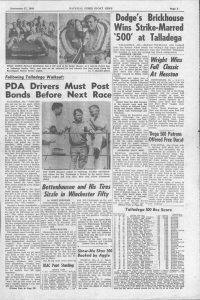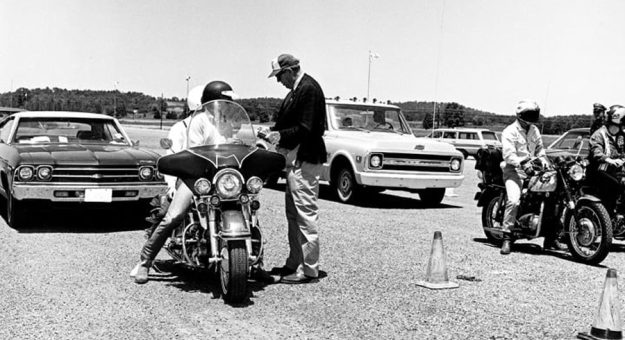Editor’s Note: NASCAR is celebrating its 75th anniversary in 2023. SPEED SPORT was founded in 1934 and was already on its way to becoming America’s Motorsports Authority when NASCAR was formed. As a result, we will bring you Part 22 of a 75-part series on the history of NASCAR as told in the pages of National Speed Sport News and SPEED SPORT Magazine.
Bill France drove NASCAR over rough roads in 1969 just as he always had: by mashing the accelerator to the floorboard.
The season began on a positive note with Firestone’s alteration of its decision to quit racing. Instead of a complete withdrawal, the tire company established a $750,000 prize for drivers using Firestone tires in at least 75 percent of their starts.
The lion’s share of the Grand National division’s $649,000 share of the awards was to be distributed to the top 20 drivers in the point standings at the end of the season. The remainder of the Grand National prizes were to be awarded to the season’s top owners and to top finishing drivers in selected races.
Independent and factory-backed drivers alike were elated.
Independent driver James Hylton said, “I think it’s the greatest thing that ever happened to stock car racing. It makes everybody eligible for the money.” Dodge factory driver Buddy Baker agreed: “This is the most important single step stock car racing has taken in its history.”
Another important step was the opening of four new tracks on the Grand National circuit. Michigan lnt’l Speedway hosted its first event, the Motor State 500 on June 15. Superspeedway driver extraordinaire Cale Yarborough won the inaugural race on the $5 million, two-mile oval.
On July 6, Dover Downs Int’l Speedway in Delaware held the first Mason-Dixon 300. Richard Petty captured the checkers on the one-mile oval. Farther south, Texas lnt’l Speedway was home to the initial Texas 500 on Dec. 7 and short-track star Bobby Isaac was the victor.
The largest new track to wave the green flag in 1969 was Alabama Int’l Speedway, and the Bill France-owned Talladega, Ala., 2.66-mile tri-oval took Grand National race speeds to a level never broached before, even at Daytona lnt’l Speedway.
Those speeds caused much uproar in the Grand National garage, as Bobby Isaac grabbed the pole with a speed of 196.386 mph in his Dodge Daytona, while Richard Brickhouse won the $25,000 top prize on Sept. 14 by averaging 153.778 mph.
“When we came down here (Talladega), it was something like the astronauts going to the moon, observed the racing director for Goodyear, Chuck Blanchard. Blanchard was commenting on the unusually high tire wear on the new track, which caused a boycott by the newly-formed Professional Drivers Ass’n on the grounds that Alabama Int’l Speedway was unsafe.
A Secret Drivers’ Meeting
The PDA was formed in a secret drivers’ meeting the night before the Aug. 17 Yankee 600 at Michigan Int’l Speedway.
Led by Petty, Yarborough and Elmo Langley, the union desired long-term fringe benefits for drivers, including a pension·plan and overall improvement in working conditions. High on the list was a reduction in the number of days spent at each track between qualifying and race day.
France was unmoved by the PDA’s initial aims and angered when Petty requested that France postpone the Talladega 500 because the track was too fast for the drivers and the racing was too rough for the equipment. “Richard, if you don’t like the track, load up your car and get out,” was France’s retort.
Petty and 30 other drivers did just that, which left a field of 35 lesser-known, non-union drivers and one former union driver to start the race. Brickhouse, who resigned from the PDA to take Charlie Glotzbach’s place in the No. 99 Dodge Charger, won an accident-free race over Jim Vandiver and Ramo Stott.
Pearson Peaks
David Pearson drove to his second consecutive Grand National Championship in 1969. The 34-year-old pilot raced his “Talladega” to 11 victories in 51 starts. He also guided the No. 17 car to a record-tying 42 top-five finishes while leading 39 races on the year.

Testament to Pearson’s ability is the variety of races in which he excelled. Pearson won the Carolina 500 on North Carolina Motor Speedway’s paved one-mile oval despite being held back for one lap because he passed the caution car as he exited the pits.
The following week, on March 16, he captured the 100-mile Cracker 200 at Augusta (Ga.) Raceway after leader Bobby Isaac’s 28-second pit stop put him one lap behind the No. 17 car.
The 1969 champ also won the Home State 200 at State Fairgrounds Speedway, one of only three remaining dirt tracks on the Grand National circuit. Pearson secured his victory on the Raleigh, N.C., hall-mile oval after a hard-charging Petty slid off the track and into the red clay.
The 1969 Ford pilot also won the Michigan 600, which only totaled 330 miles because rain delays and darkness forced cancellation of the first race on the superspeedway.
The only driver to better Pearson’s number of victories was Bobby Isaac. The top short-track driver on the circuit in 1969, Isaac sped to 17 victories in his 50 starts. The 1969 Dodge Charger driver also led 5,072 laps and grabbed 21 poles. Yet, with only 33 top-10 finishes, he fell to third behind Petty in the final standings.
While Petty totaled 10 victories in a Ford Torino, he was unhappy with the treatment afforded by the auto maker. Petty Enterprises prided itself on prepping its own engines, but with Holman-Moody serving as Ford’s ace car builder, the Petty team felt as if it were always second in line for parts. Hence, at the end of the 1969 season, Petty returned to his Plymouth “family.”
Chrysler driver Ray Elder won the Pacific Coast Late Model division title. Carl “Bugs” Stevens earned his third straight Modified ring, while Ken Rush was the Grand Touring champion. Late Model Sportsman titlist Red Farmer won 31 of 78 races and Dick Brooks became NASCAR’s rookie of the year.
NASCAR Signs First Long-Term TV Deal
The season ended on a bittersweet note.
Firestone declared its $750,000 prize fund a failure because virtually all of the top drivers were under exclusive contract to rival Goodyear and decided to stop participating in motorsports. However, NASCAR signed its first long-term television deal when ABC agreed to televise 35 races in the next three seasons.
The $1.4 million contract called for five live and four taped broadcasts in 1970 and 13 total shows in each of the next two seasons.
Interestingly, NASCAR still held the rights to the broadcast and dictated which races would be shown via an intricate formula wherein tracks that did not make the TV cut received some financial benefit from the rights.
Once more, NASCAR pushed through adversity and emerged stronger than ever.
